*[CLICK ON THE PICTURES TO GET A CLEARER & BIGGER VERSION :)]
This time's Semakau survey had less to do with the intertidal region and more to do with the mangrove flora of the reclaimed island. Besides 'topping up' on what I knew about mangroves (and it's not much to be honest), it was a new experience for me to explore what I used to learn back in secondary school. All I can recall from secondary school, is that mangroves consists of plants of 3 main [Edit] genera: the Rhizophora spp., the Bruguiera spp. and the Soneratia spp. (which I later found out was slightly incorrect for the diversity that can be found in this particular habitat is as vast as the ones that are non-coastal; even if mankind had left a mark on it.)
Avicennia spp.
The first mangrove species which I laid my eyes on were from the genus Avicennia. There are altogether 4 species of the Avicennia stated in the 'Comparative Guide to Mangroves' by Jean Yong [1].
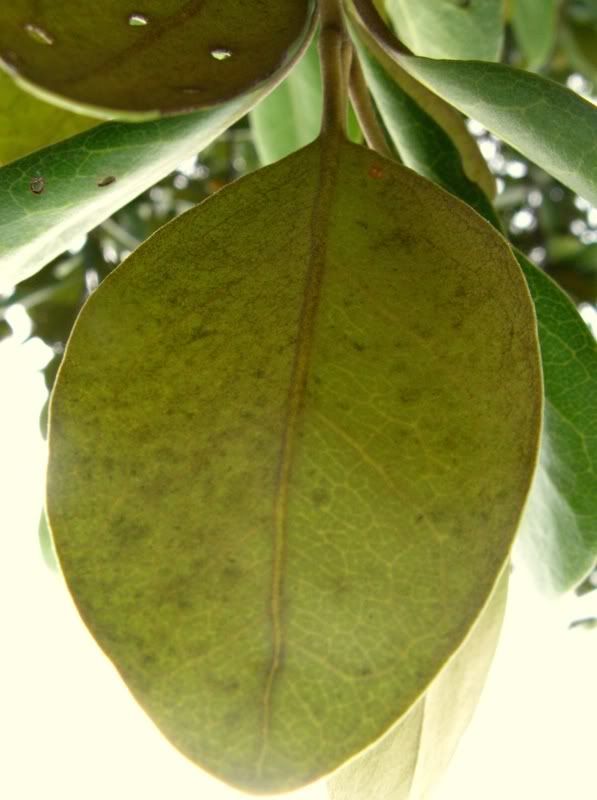 ___
___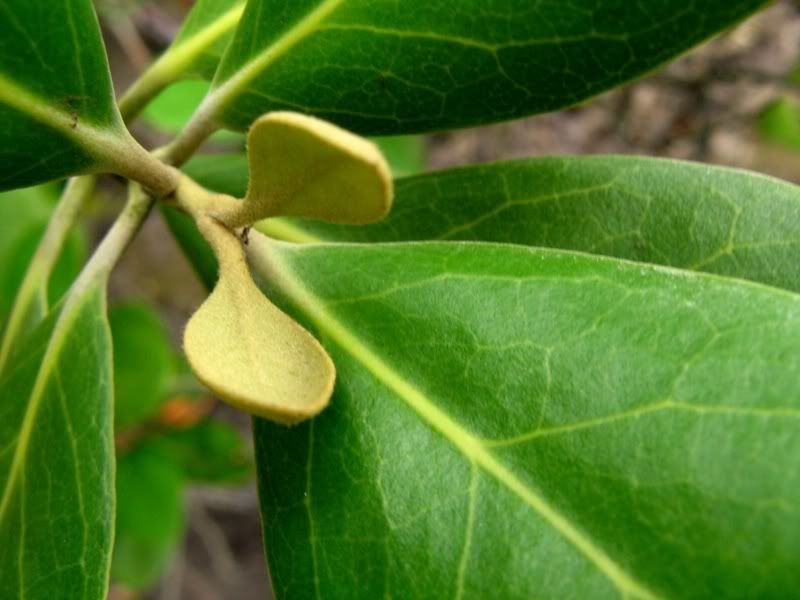
(Left): The brown, leathery underside of the Avicennia rumphiana. Another way to distinguish this species of Avicennia is by the slight curvature of the sides of its leaves.
(Right): When young, the juvenile leaves look very much like cupped ears, which is gradually lost as it gets older. But isn't the shape just adorable? =)
(Right): When young, the juvenile leaves look very much like cupped ears, which is gradually lost as it gets older. But isn't the shape just adorable? =)
 ___
___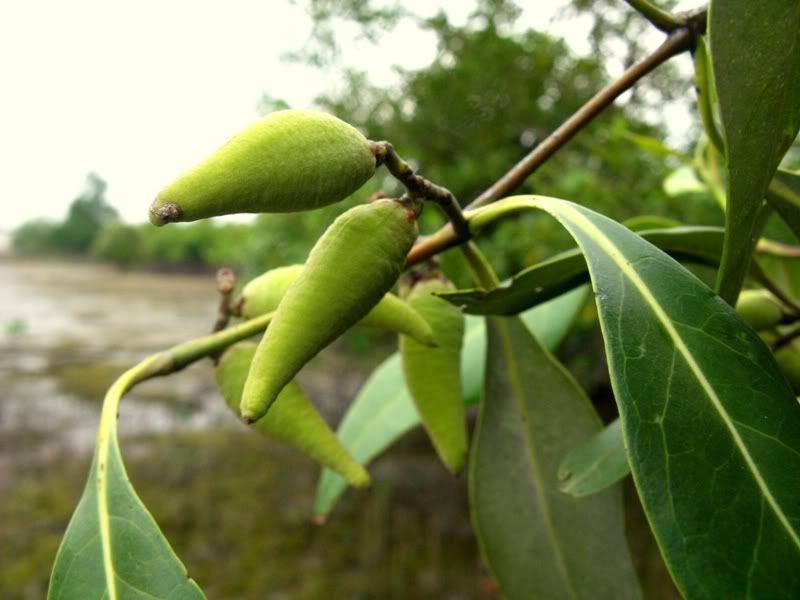
The fruit of the A. rumphiana (left) is wrinkled-looking compared to the other Avicennia fruits, such as the A. alba (right). A. rumphiana looks more like a heart-shaped locket while the A. alba has more of elongated, tear-shaped resemblance. Sweet!
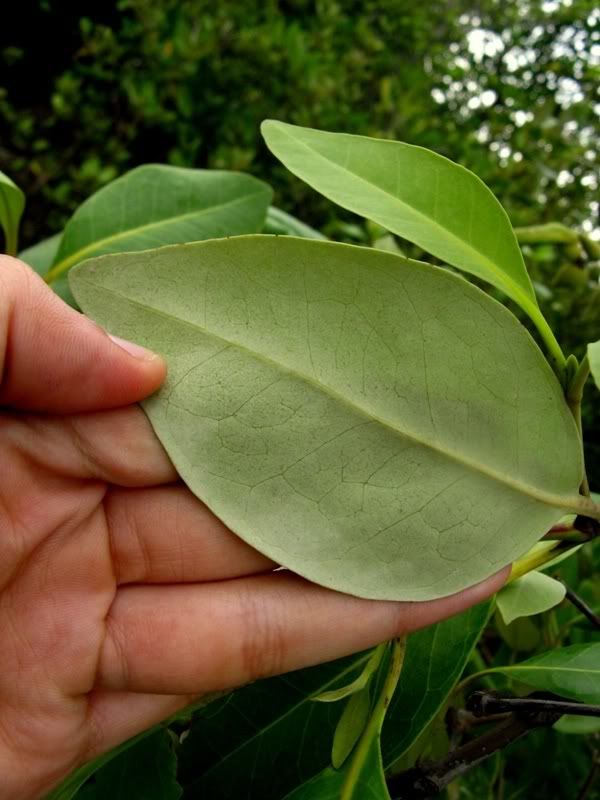 ___
___
(Left): The underside of A. alba leaves are rather whitish hence its species epithet "alba" which means white in Latin. Generally, juvenile leaves or leaves that grow under shade tend to be rounder and bigger, so that there's a larger surface area to receive more sunlight for photosynthesis.
(Right): The adult leaves have a slightly elongated characteristic to it.
(Right): The adult leaves have a slightly elongated characteristic to it.
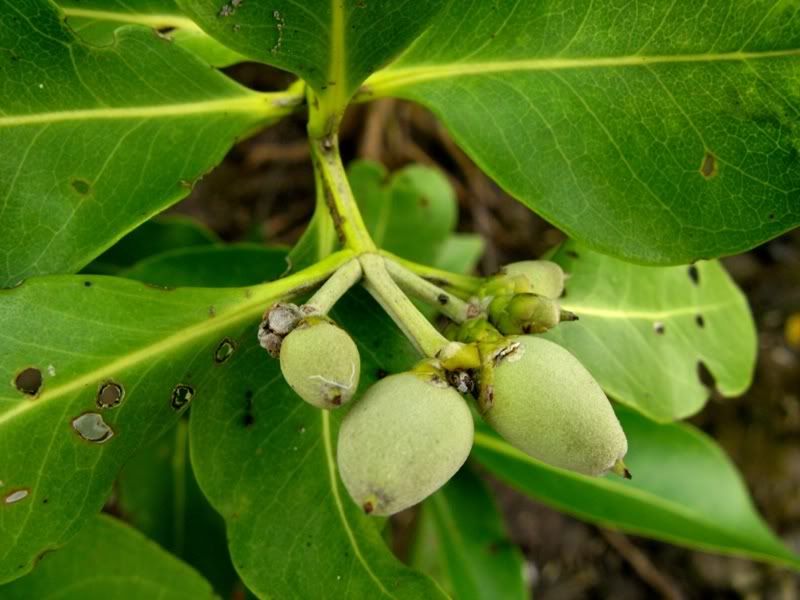 ___
___
(Left): Compared to the A. alba, the underside of the A. marina's leaves are more greenish. And unlike the elongated fruits of the A. alba, the fruits of the A. marina are regular tear-drop shapes.
(Right): Another of their distinctive features is their squarish stems. However, one has to be careful because the A. alba also have squarish stems in their juvenile phase.
(Right): Another of their distinctive features is their squarish stems. However, one has to be careful because the A. alba also have squarish stems in their juvenile phase.
Bruguiera spp.
Another familiar mangrove species that we bumped into was from the genus Bruguiera. There were 2 of them, with one being the Bruiguiera gymnorhiza while the other the Bruguiera cylindrica
Another familiar mangrove species that we bumped into was from the genus Bruguiera. There were 2 of them, with one being the Bruiguiera gymnorhiza while the other the Bruguiera cylindrica
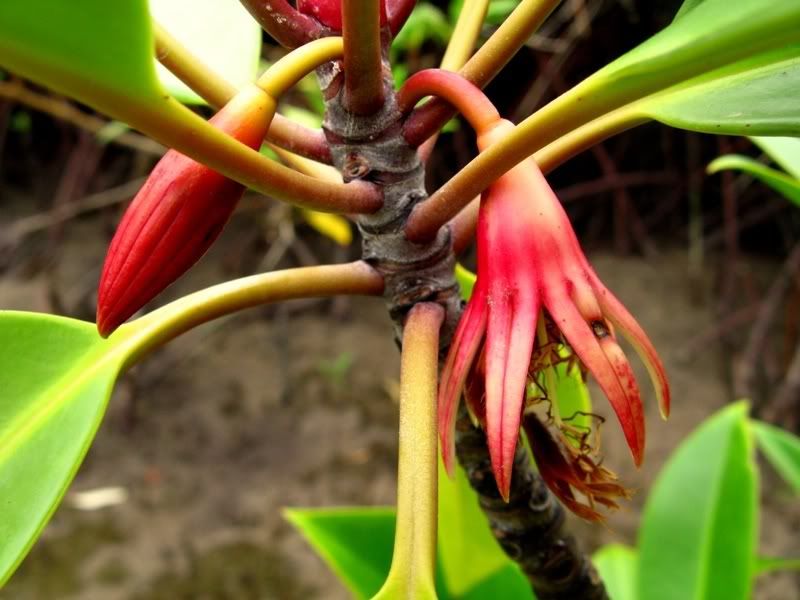 ___
___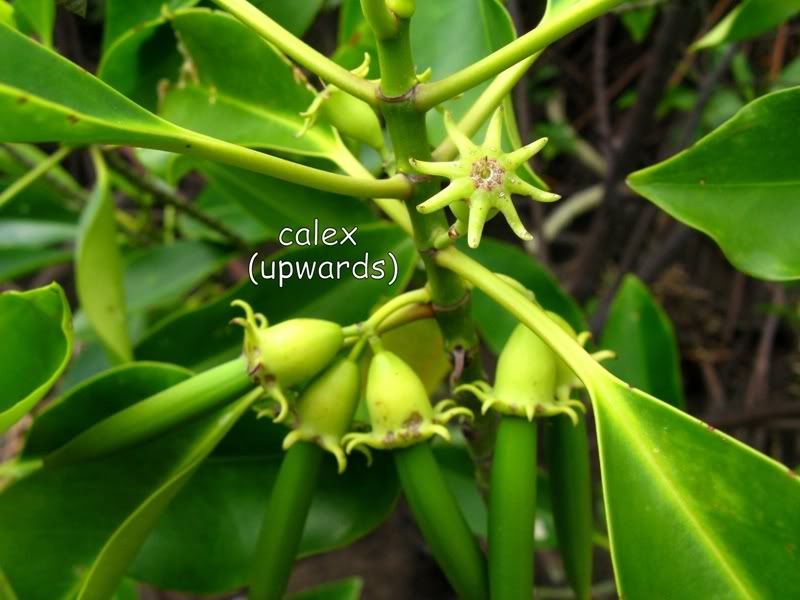
(Left): One can easily recognize the B. gymnorhiza by its flaming red calex. It's the only Bruguiera species known to sport such a hue. Apparently, at some parts of the world, ladies string the calex together to wear around their necks. :D
(Right): B. cylindrica and its distinctive upward-directed calex. So keep your eyes peeled for the Bruguiera's calex for they reveal much about the plant's identity.
(Right): B. cylindrica and its distinctive upward-directed calex. So keep your eyes peeled for the Bruguiera's calex for they reveal much about the plant's identity.
Ceriops spp.
In this tiny island, two types of Ceriops can be found. They are the Ceriops zippeliana and the Ceriops tagal. In fact, Ceriops spp. [Edit] (aside from the Scyphiphora sp. which has pointed flattened buds) are the only mangrove plants with flattened buds [4].
In this tiny island, two types of Ceriops can be found. They are the Ceriops zippeliana and the Ceriops tagal. In fact, Ceriops spp. [Edit] (aside from the Scyphiphora sp. which has pointed flattened buds) are the only mangrove plants with flattened buds [4].
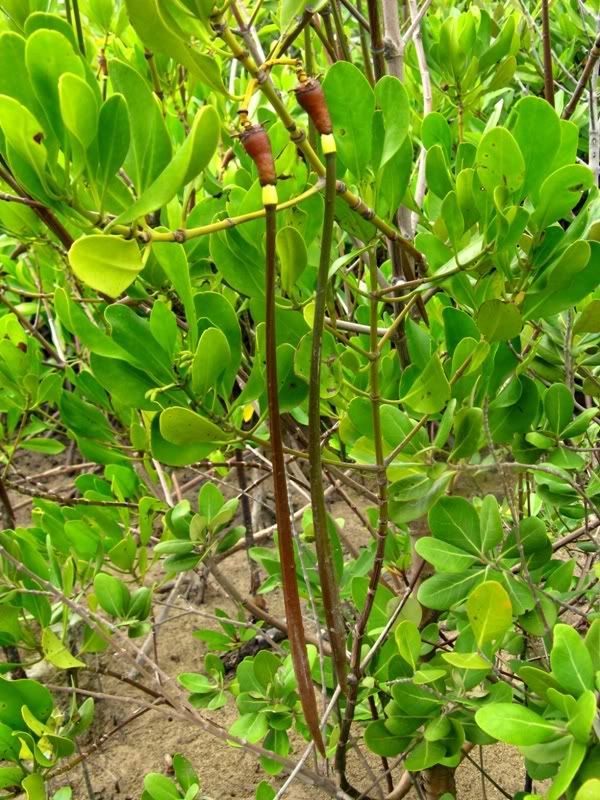 ___
___
See the long, slender propagules of the Ceriops on the left. It isn't round like the Rhizophora, instead, it's distinctively angular about the edges if you look at it closely (right). Of course, a feel will be enough to confirm one's deductions. ;)
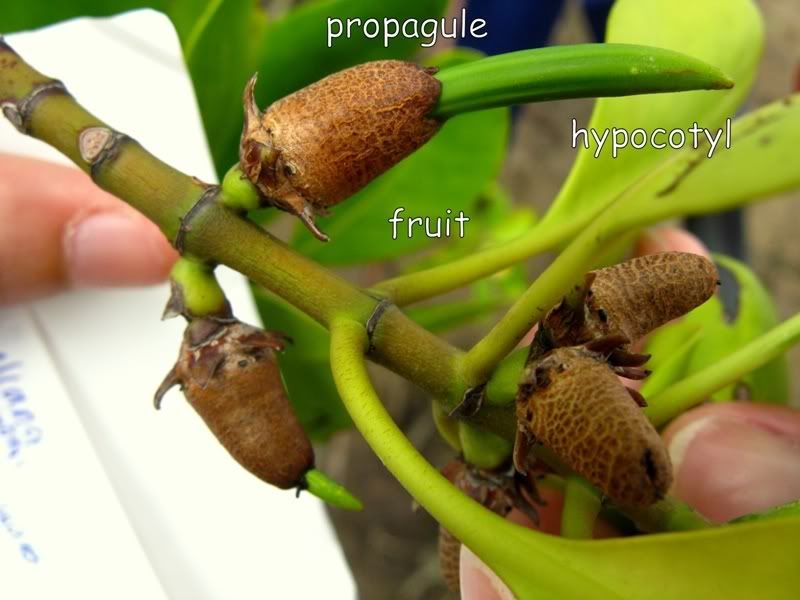 ___
___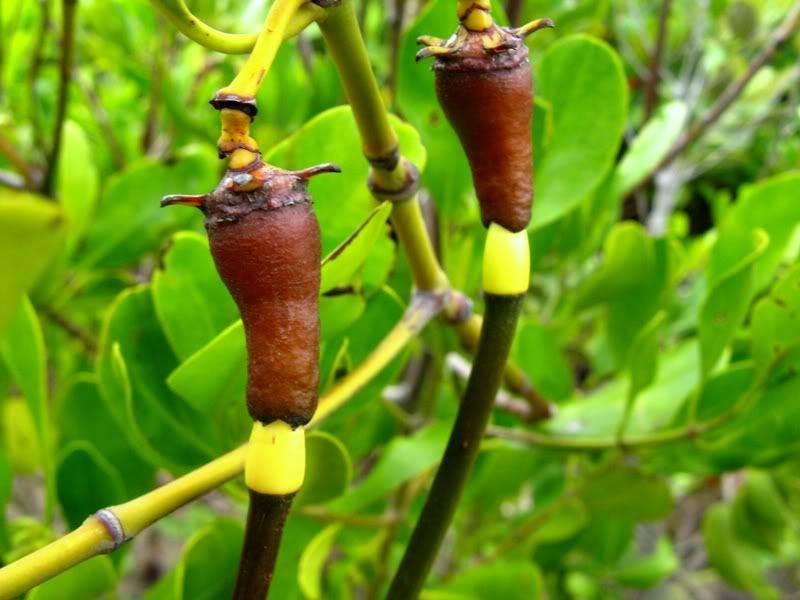
There are 2 ways to tell apart the C. zippeliana from the C. tagal. Firstly, we need to know what is the fruit, hypocotyl and propagule.
Simple equation: fruit (aka calyx) (brown) & hypocotyl (green) --> propagule (the entire length)
C. zippeliana (left) has an mosaic-patterned fruit while the C. tagal (right) has none on the fruit. Another way is via its collar (the portion between the fruit and the hypocotyl). In the picture on the left, the juvenile C. zippeliana still has yet to have its collar. And if it does, it will be of a red colour, which is different from the yellow collar of the C. tagal (right).
Simple equation: fruit (aka calyx) (brown) & hypocotyl (green) --> propagule (the entire length)
C. zippeliana (left) has an mosaic-patterned fruit while the C. tagal (right) has none on the fruit. Another way is via its collar (the portion between the fruit and the hypocotyl). In the picture on the left, the juvenile C. zippeliana still has yet to have its collar. And if it does, it will be of a red colour, which is different from the yellow collar of the C. tagal (right).
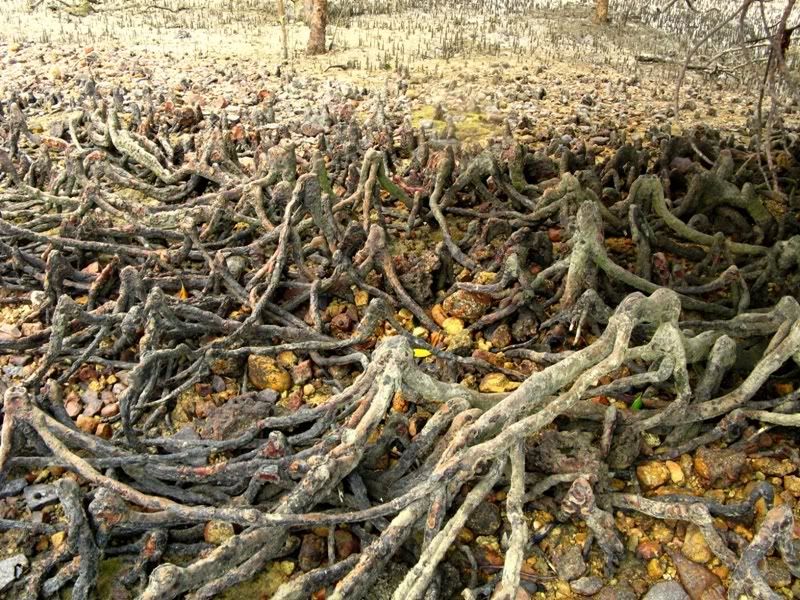 ___
___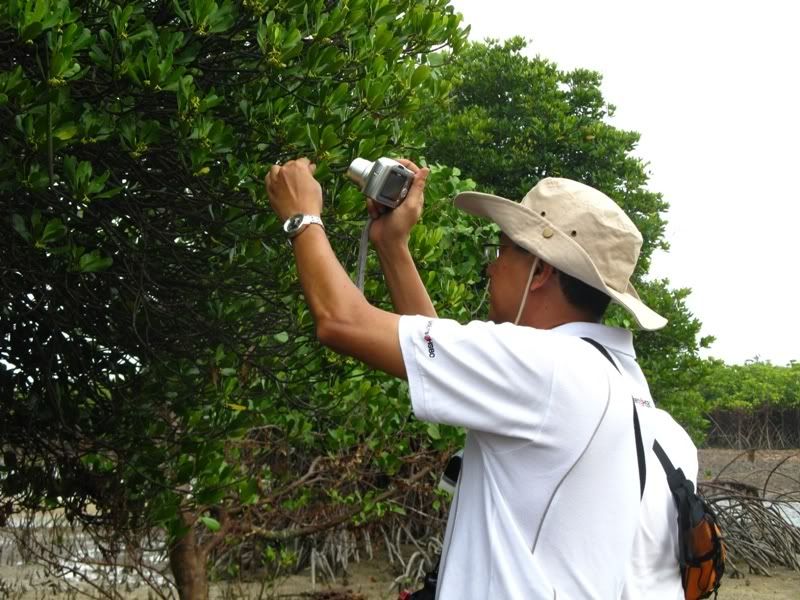
(Left): Apparently, Bruguiera's are not the only mangrove plants with kneed roots. The Ceriops also have roots that is shaped like knees.
(Right): Nonis taking a picture of the plant. He wasn't the only one, I was snapping like mad too, so that I don't miss out the distinctive characters that are special to each and every mangrove plant. ^-^
(Right): Nonis taking a picture of the plant. He wasn't the only one, I was snapping like mad too, so that I don't miss out the distinctive characters that are special to each and every mangrove plant. ^-^
Soneratia spp.
There are altogether 3 species of Sonneratia found in Singapore. But we only chanced upon one species - the Sonneratia alba which is also sometimes called the 'Mangrove Apple' [2].
There are altogether 3 species of Sonneratia found in Singapore. But we only chanced upon one species - the Sonneratia alba which is also sometimes called the 'Mangrove Apple' [2].
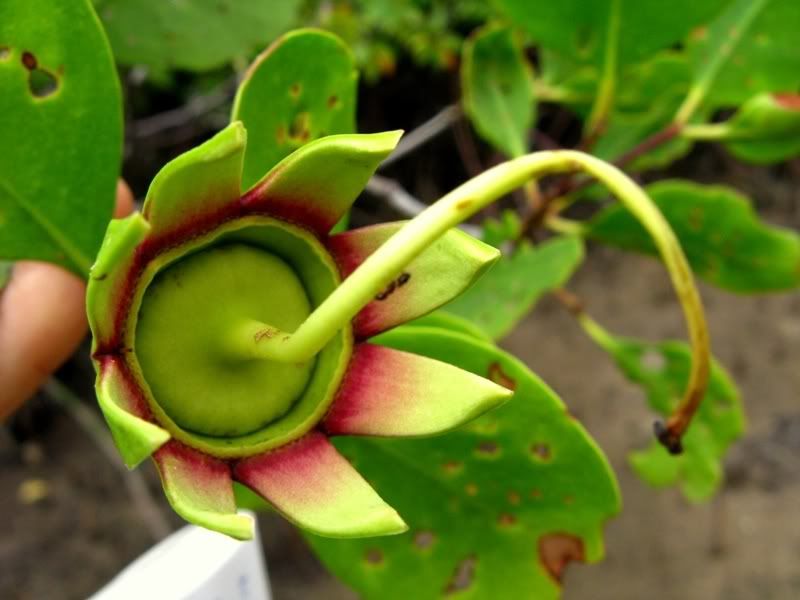 ___
___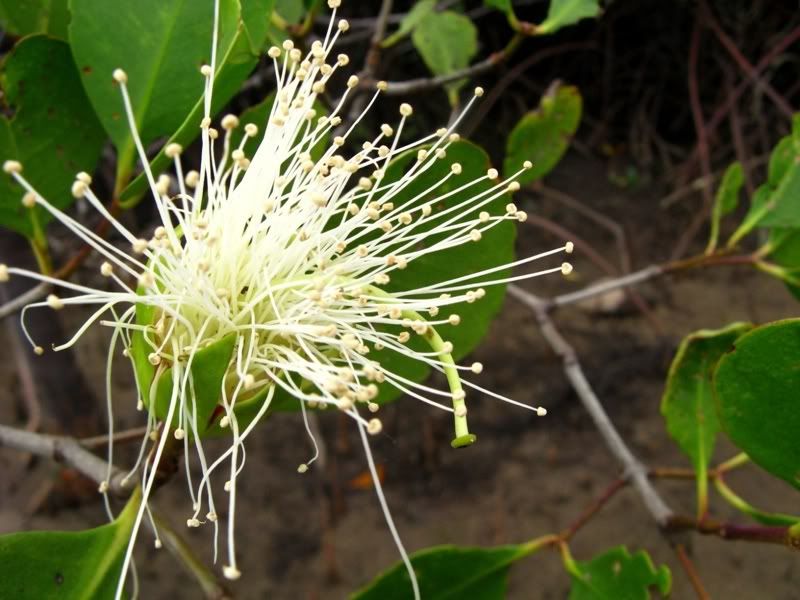
(Left): The pistil (female reproductive organ) of the S. alba devoid of its surrounding stamens (male reproductive organ).
(Right): The flower with everything intact. Usually, it blooms at dusk. Then, an abundant amount of dry/slightly sticky pollens are released to be dispersed by bats [2].
(Right): The flower with everything intact. Usually, it blooms at dusk. Then, an abundant amount of dry/slightly sticky pollens are released to be dispersed by bats [2].
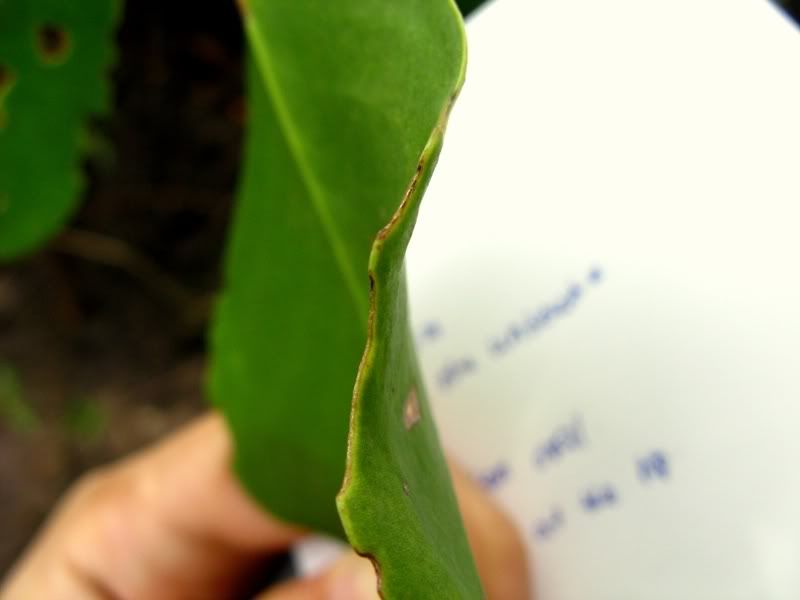 ___
___
One way to recognize the Sonneratia besides its unique flower is the copperish-red hue at its leaf edge. On that particular Saturday, we had a hard time distinguishing this species for there were a few of them with different leaf shapes. According to the Expose, the leaves are broadly egg-shaped... hmmm. It confounded us for a quite a while till we saw its flowers. Its charateristic bloom's always a dead give-away. =)
Rhizophora spp.
No mangrove is complete without its Rhizophora species (aka Bakau). There are also altogether 3 species of bakau which can be found in Singapore and we saw all 3 [3]. They are the:
(i) Bakau Minyak (Rhizophora apiculata)
(ii) Bakau Kurap (Rhizophora mucronata)
(iii)Bakau Pasir (Rhizophora stylosa)
Rhizophora spp.
No mangrove is complete without its Rhizophora species (aka Bakau). There are also altogether 3 species of bakau which can be found in Singapore and we saw all 3 [3]. They are the:
(i) Bakau Minyak (Rhizophora apiculata)
(ii) Bakau Kurap (Rhizophora mucronata)
(iii)Bakau Pasir (Rhizophora stylosa)
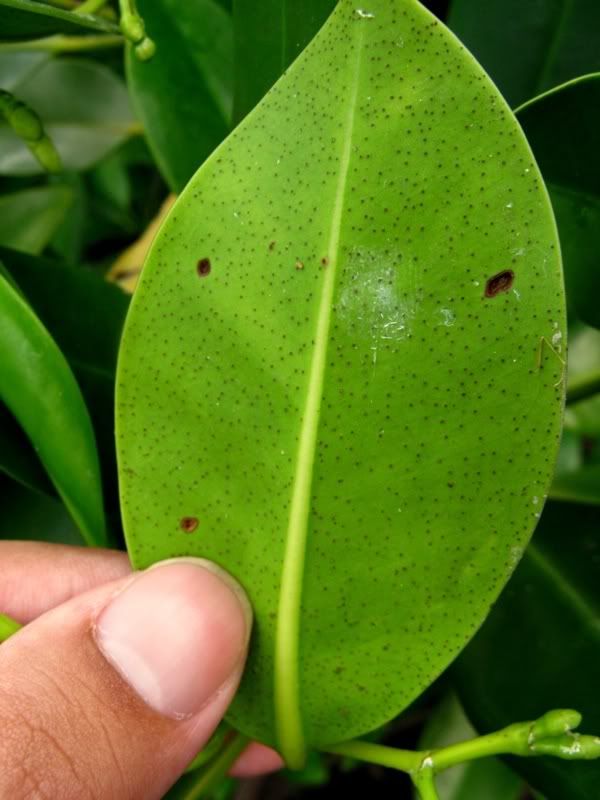 ___
___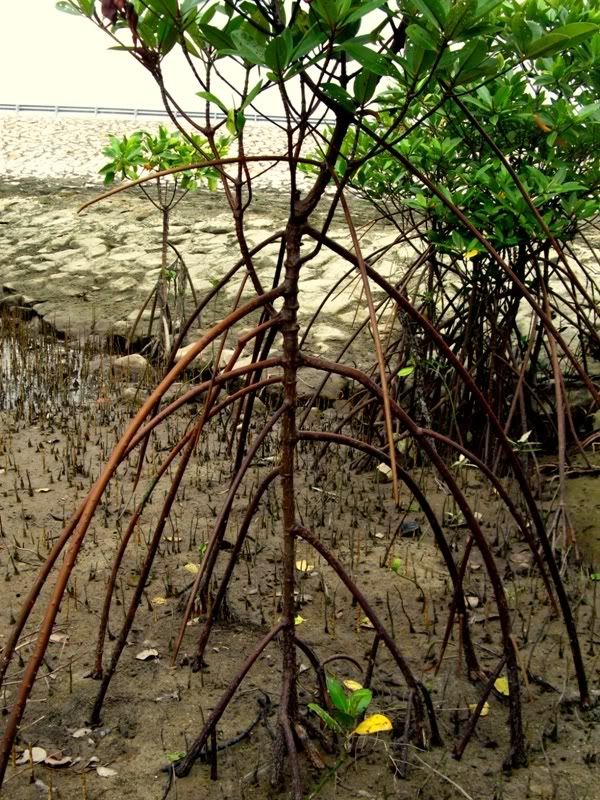
(Left): One easy way to distinguish Rhizophora plants from the other mangrove species is by the black dots that are found under the species.
(Right): The roots that support the plant on its soft, muddy and waterlogged substrate are called prop roots, which after some time, are called stilt roots (after having lost the base of the trunk below the attachment point of the prop roots).
(Right): The roots that support the plant on its soft, muddy and waterlogged substrate are called prop roots, which after some time, are called stilt roots (after having lost the base of the trunk below the attachment point of the prop roots).
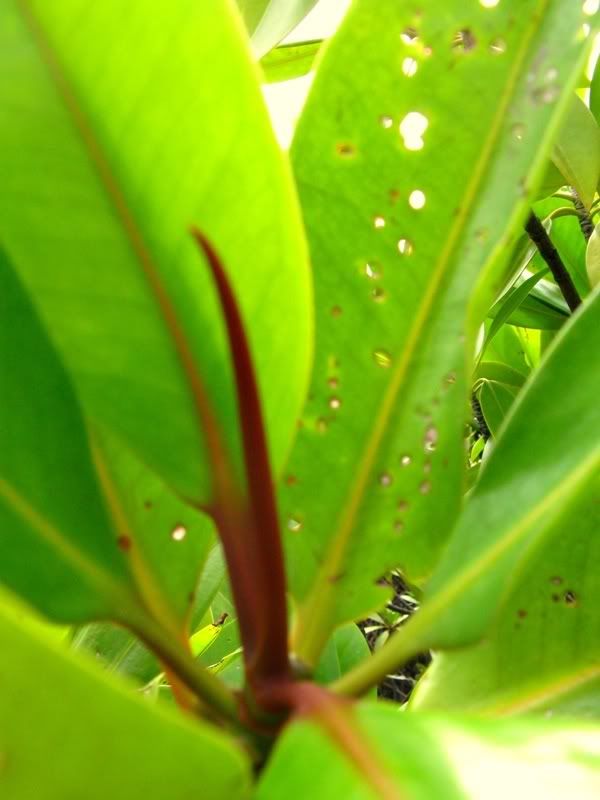 ___
___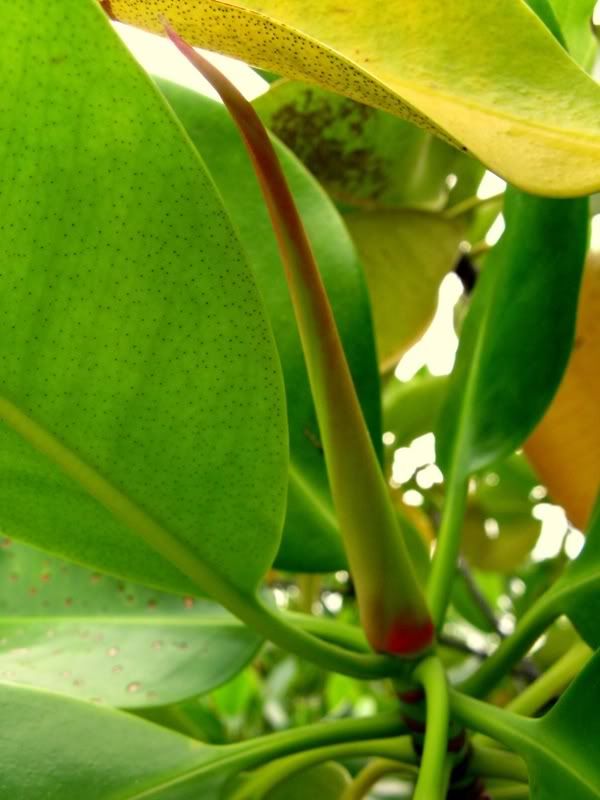
There are a few ways to differentiate the various species of the Rhizophora. One of them is via its stipules. The R. apiculata (left) has totally red stipules while the R. mucronata (right) has semi-red stipules or green ones. It's never a total 100% red.
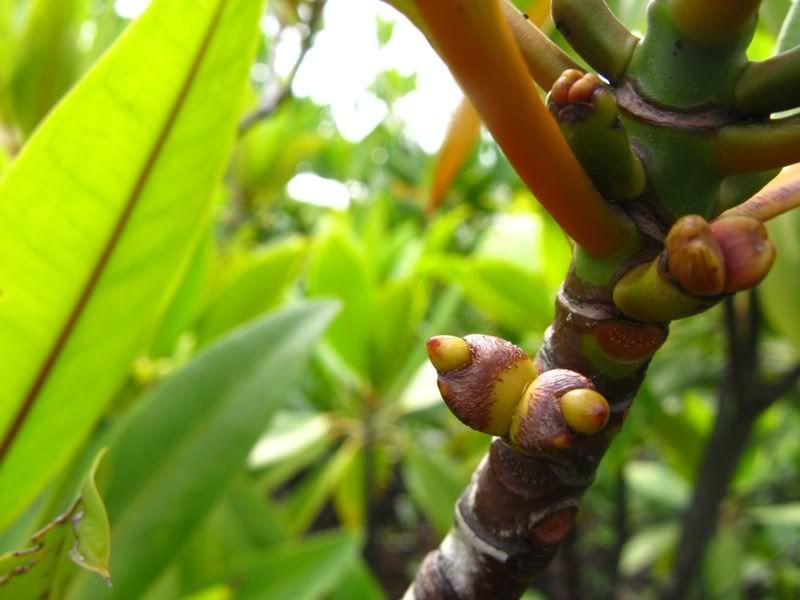 ___
___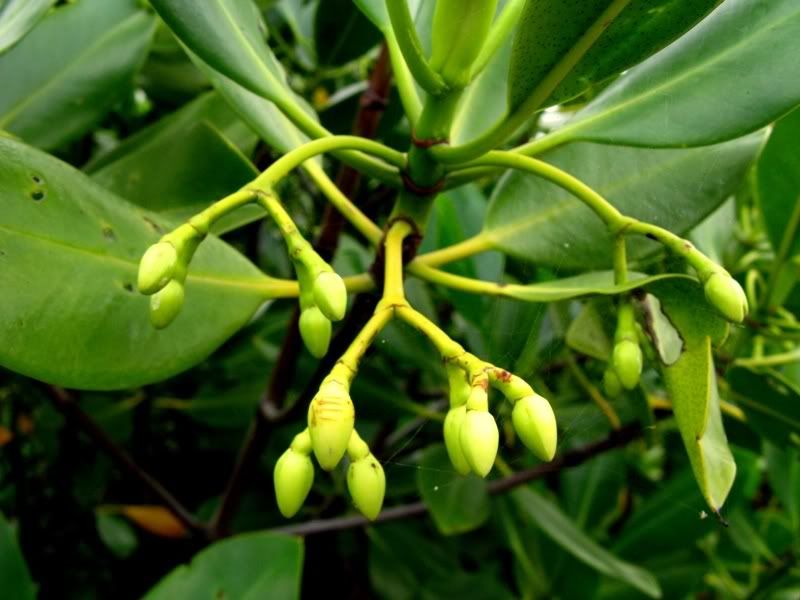
Another distinctive feature is via its flowers. The R. apiculata (left) has flowers growing directly from its stems in a cluster while both the R. mucronata and the R. stylosa (right) have their flowers growing out in a lantern-like manner.
 ___
___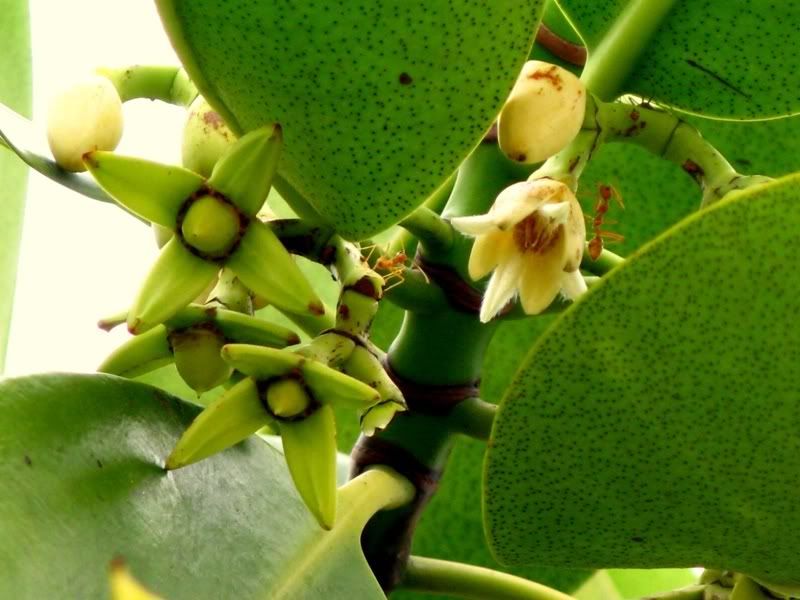
And to distinguish between R. mucronata and the R. stylosa, looking at their flowers is one way. The R. stylosa (left) has a long style (the thread-like protrusion from the end of its flower) while R. mucronata (right) has a short one, which you can barely see in the picture unless you scrutinize the blooms properly. ^_^
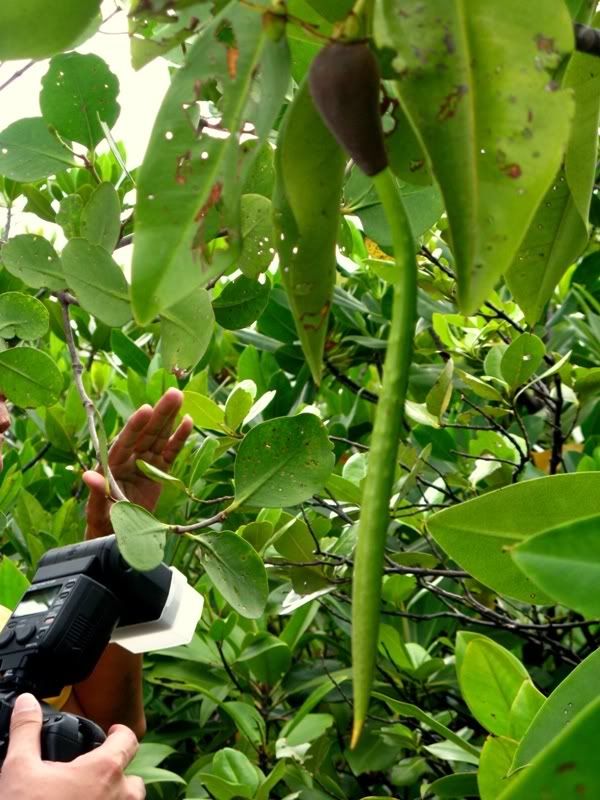 ___
___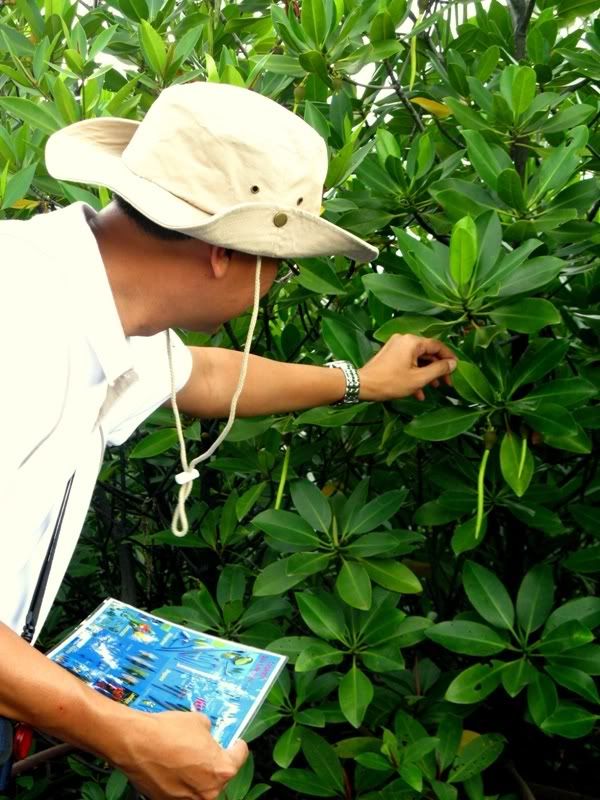
Propagules can also be used to distinguish between the two. Although both can grow very long, (R. stylosa - 60cm; R. mucronata - 75cm or more), the R. mucronata (left) are a duller olive green while the R. stylosa (right) are more of a brighter yellowish green.
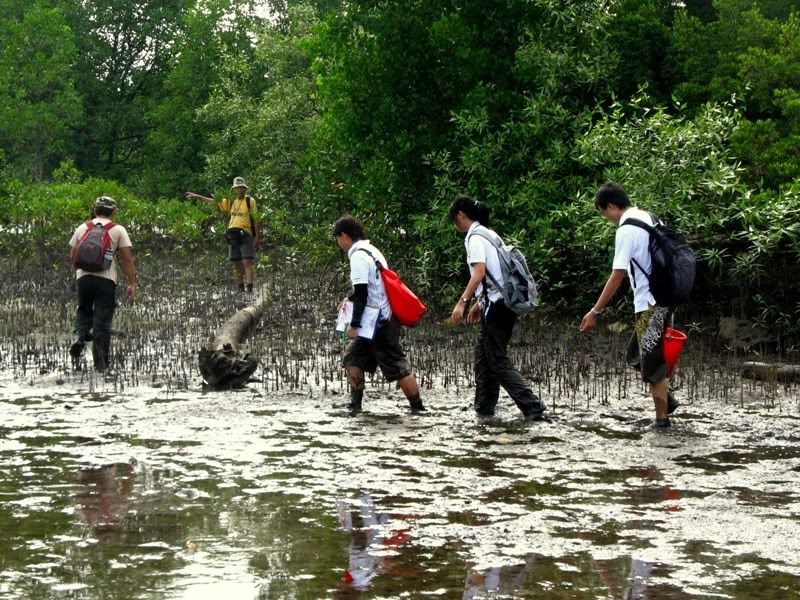 ___
___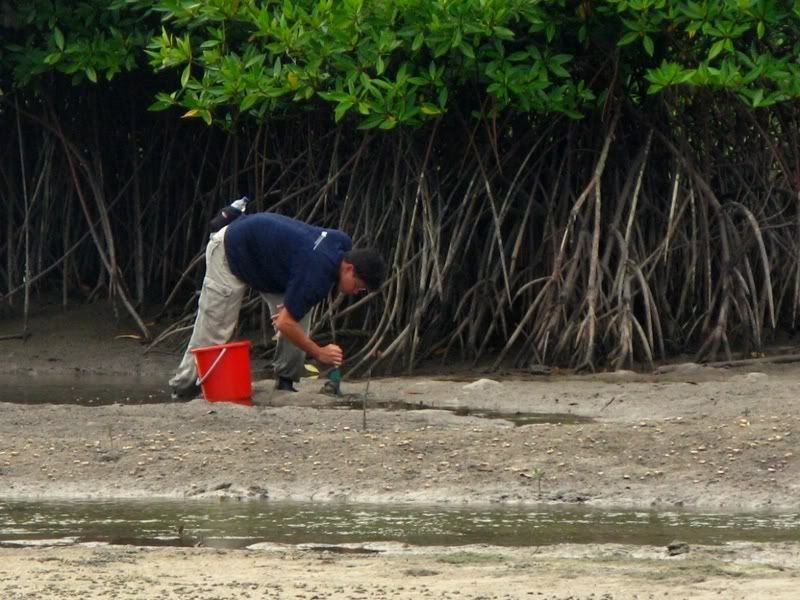
 ___
___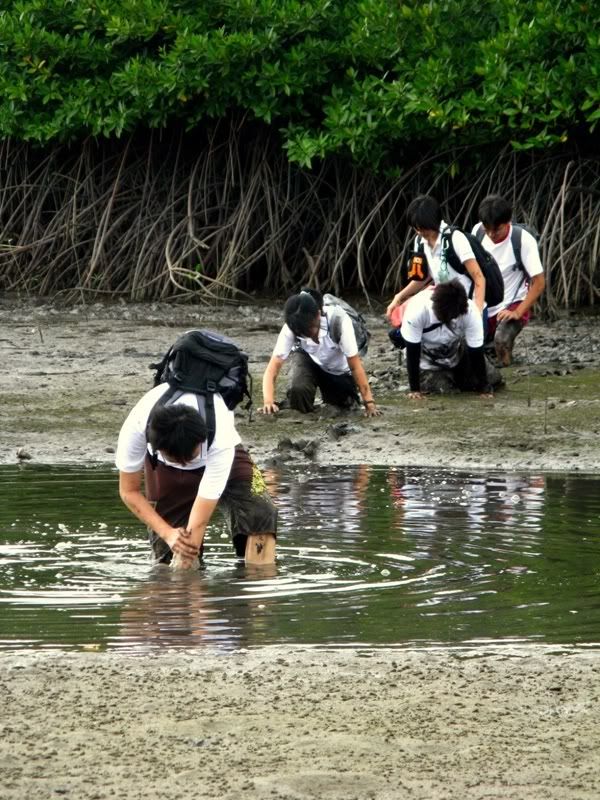
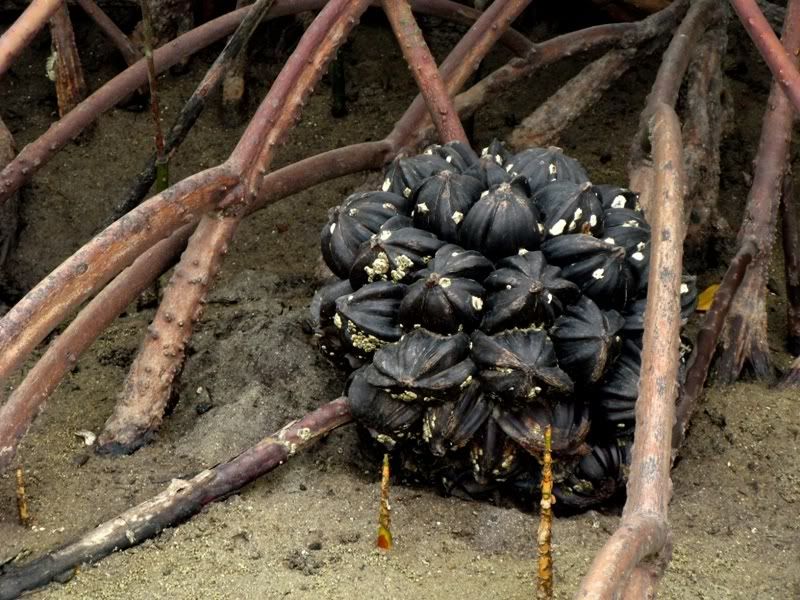 ___
___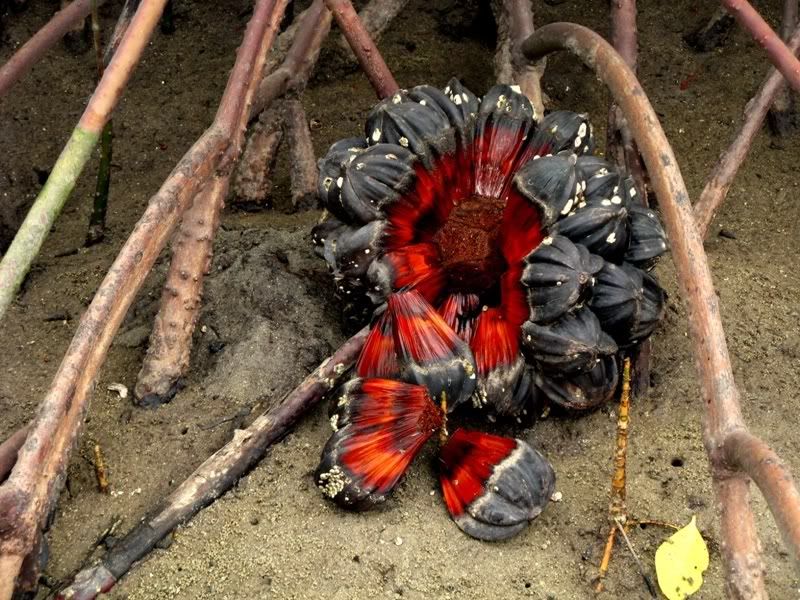
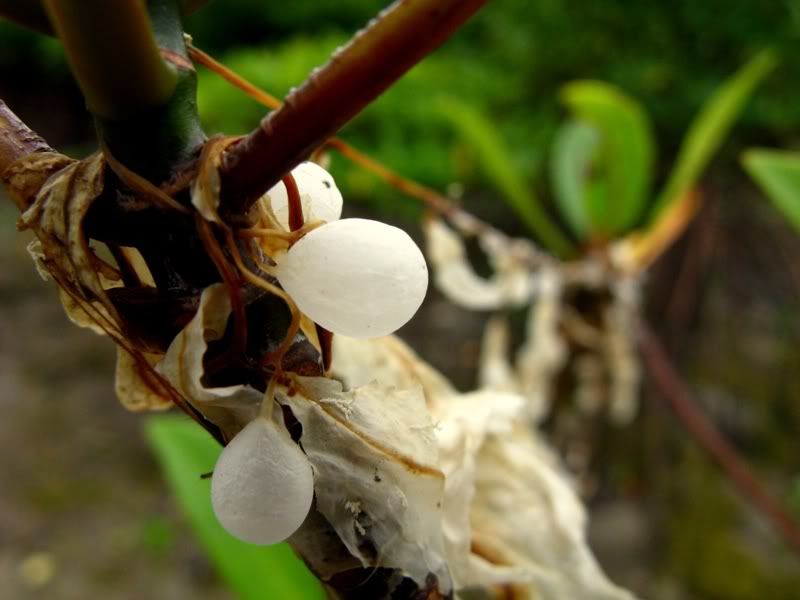 ___
___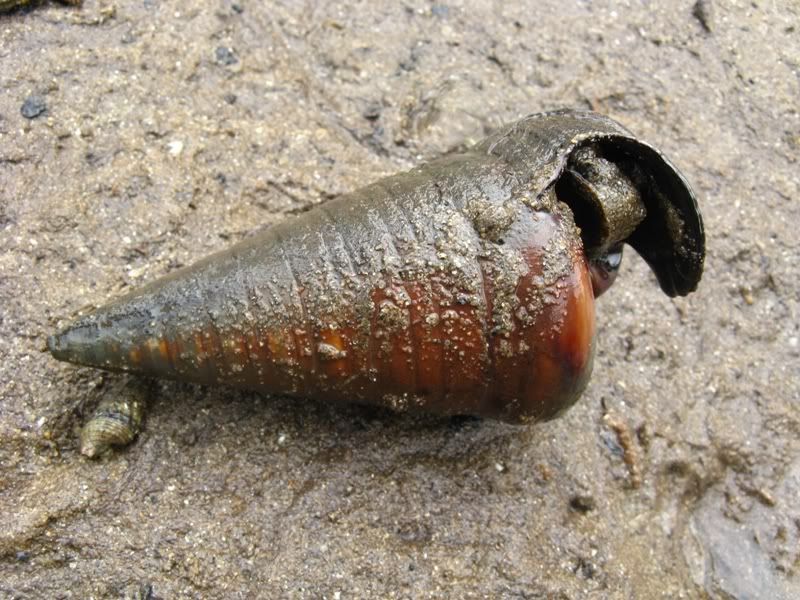
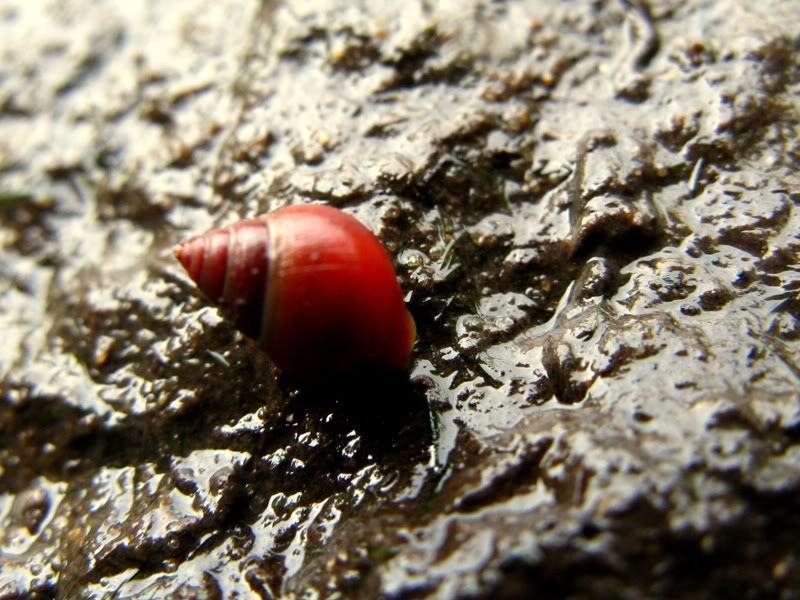 ___
___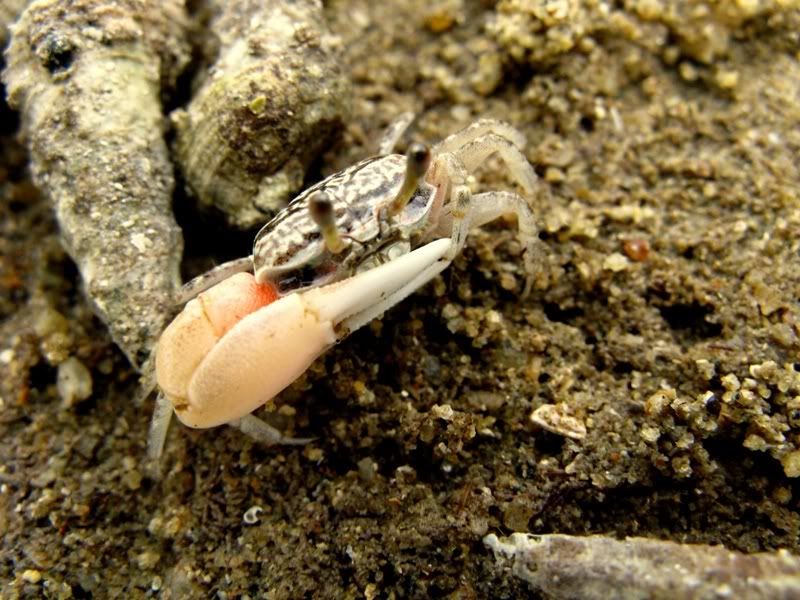
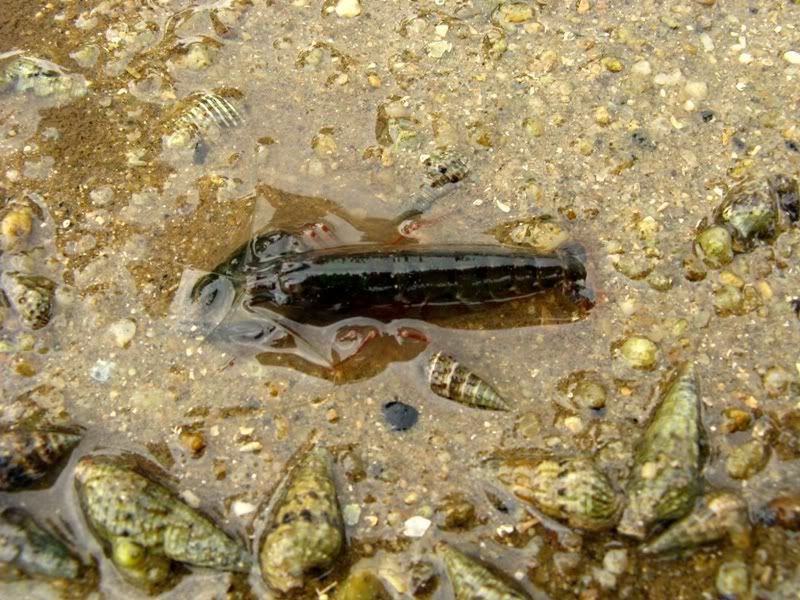 ___
___
 ___
___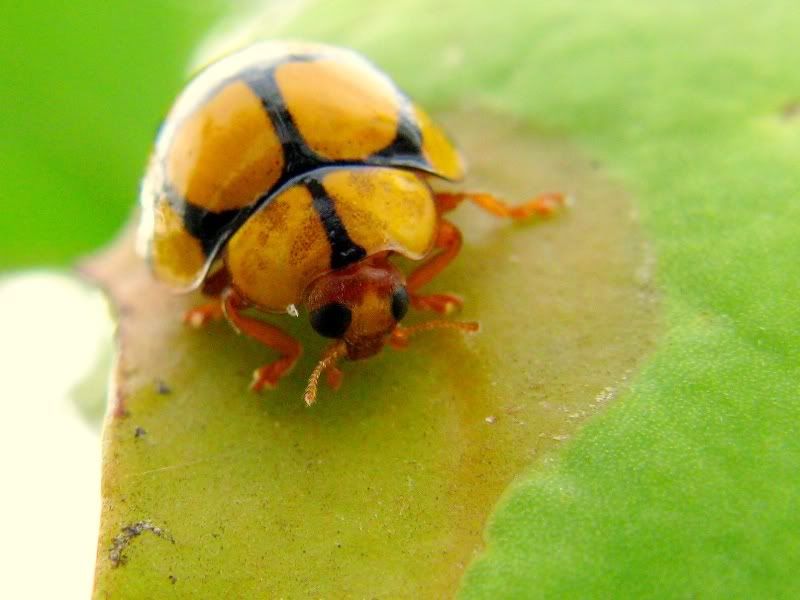
Reference:
1. http://rbiology.wordpress.com/2007/09/26/comparative-guide-to-mangroves/
2. Private Lives: An Expose of Singapore's Mangroves, p.38-39.
3. Private Lives: An Expose of Singapore's Mangroves, p.31-32.
4. Private Lives: An Expose of Singapore's Mangroves, p.41-42.
5. http://mangrove.nus.edu.sg/guidebooks/text/2084.htm
6. http://mangrove.nus.edu.sg/guidebooks/text/2083.htm
7. http://www.brisbaneinsects.com/brisbane_ladybirds/Netty.htm
 ___
___
While most of us were doing a survey on the mangroves, Siong Kiat, curator of cnidarian, crustacean and echinoderm collections of the Raffles Museum was busy doing a survey on his own on the gastropod species of Semakau Island.
 ___
___
Though we got ourselves sunk thigh-high into the mud (most of us that is except yours truly and a few others), we were all rather gung-ho when doing the mangrove survey. After all, we could always washed the residue away in some of the cool streams that meandered its way through the mangroves. =)
 ___
___
Besides the mangrove plants above, we also had a little luck spotting a lone Nipah (Nypa fruticans) fruit at the edges of the mangrove habitat. This plant should be quite familiar to everyone for its seed, the attap chee, is loved by one and all (especially in the ice kacang dessert). Yummm~~ And boy was the fruit huge, I think it spanned about 45-50 cm in length. However, according to Eddie, the attap chee or whatever that's left in the fruit would have probably rotted. Why? The barnacles growing on top of it is a good indication on how long this lone fruit has floated out in the seas before it landed on this spot.
 ___
___
(Left): The dried out air sacs of the Sargassum sp.. It got left onto the mangrove plants after the tide retreated back into the sea. At first glace, they reminded me of lizard's eggs (the ones that climb onto ceilings and just about anywhere and everywhere in a house).
(Right): The Rodong (Telescopium telescopium) is also known as the 'gua cha deng' or 'coffin nail' to the Teochews. According to Eddie, it resembles rather closely to the huge nail used to seal coffins. O__O This rather large species feeds on organic detritus (disintegrated material) and surface algae found on the beach [5].
(Right): The Rodong (Telescopium telescopium) is also known as the 'gua cha deng' or 'coffin nail' to the Teochews. According to Eddie, it resembles rather closely to the huge nail used to seal coffins. O__O This rather large species feeds on organic detritus (disintegrated material) and surface algae found on the beach [5].
 ___
___
(Left): I was really excited to see the Red Berry Snail (Sphaerassiminea miniata) -though it was barely 1cm long- as I just learned about it in my Natural Heritage module. These minute crimson snails were strewn abundant on the muddy substrate. Living on waterlogged land, you would have thought it breathed via gills, but it has a lung for respiration instead [6]. ^^
(Right): Besides that, there were also the Fiddler crabs which larger cheliped (aka pincer) resembles the stance of a fiddler in action. This [Edit] Porcelain Fiddler Crab (Uca annulipes) was all ready to run and hide into one of the nearby holes but it was just too big for it.. heheh. But we let it go its way after showering it with 'celebrity treatment'.
(Right): Besides that, there were also the Fiddler crabs which larger cheliped (aka pincer) resembles the stance of a fiddler in action. This [Edit] Porcelain Fiddler Crab (Uca annulipes) was all ready to run and hide into one of the nearby holes but it was just too big for it.. heheh. But we let it go its way after showering it with 'celebrity treatment'.
 ___
___
And the highlight of my day was this Snapping Shrimp (or at least, that's what I think it was) that was lying amidst all the Creeper Snails (Family Cerithiidae). We took it for one since its right arm was clearly bigger than its left. Snapping shrimps are rarely seen away from the hole it hides itself in. In fact, this is my first time seeing it (though it definitely wouldn't be my last :P). It's too bad I couldn't capture a clear view of its distinctive claw size. Darn....
 ___
___
(Left): But even so, my day ended on a rather sweet note with the appearance of the ladybug above. Me and one of the photographers were busy clicking away just to get one nice shot of this 2-3cm insect.
(Right): Just adorable isn't it? This is the best from the dozens that I snapped. All I wanted was just a clear picture of its face and feelers. :) [Edit] According to a Singapore stamp published in 1985, this beetle was known as the Heteroneda reticulata. However, after some quick googling, it seems that the exact beetle (according to Dr Adam Slipinski), is now known as the Harmonia testudinaria (Mulsant) aka the Netty Ladybird Beetle [7].
And of course, I left the mangroves with a few lessons learned.
1) Rule of thumb, always bring booties to locations that have water. It's either that or you risk losing your shoes in the mud.
2) Must wear shorts (with detachable pants) to any field trip. It can be made short or long according to fir whichever situation. Short for wading through water-logged areas while the long prevent excessive adoration from the mosquitoes and sandflies.
** My apologies for the previous mistakes, which has been clarified and rectified.
Thanks LK, Ron & AY for the pointing out the errors! =)
(Right): Just adorable isn't it? This is the best from the dozens that I snapped. All I wanted was just a clear picture of its face and feelers. :) [Edit] According to a Singapore stamp published in 1985, this beetle was known as the Heteroneda reticulata. However, after some quick googling, it seems that the exact beetle (according to Dr Adam Slipinski), is now known as the Harmonia testudinaria (Mulsant) aka the Netty Ladybird Beetle [7].
And of course, I left the mangroves with a few lessons learned.
1) Rule of thumb, always bring booties to locations that have water. It's either that or you risk losing your shoes in the mud.
2) Must wear shorts (with detachable pants) to any field trip. It can be made short or long according to fir whichever situation. Short for wading through water-logged areas while the long prevent excessive adoration from the mosquitoes and sandflies.
** My apologies for the previous mistakes, which has been clarified and rectified.
Thanks LK, Ron & AY for the pointing out the errors! =)
Reference:
1. http://rbiology.wordpress.com/2007/09/26/comparative-guide-to-mangroves/
2. Private Lives: An Expose of Singapore's Mangroves, p.38-39.
3. Private Lives: An Expose of Singapore's Mangroves, p.31-32.
4. Private Lives: An Expose of Singapore's Mangroves, p.41-42.
5. http://mangrove.nus.edu.sg/guidebooks/text/2084.htm
6. http://mangrove.nus.edu.sg/guidebooks/text/2083.htm
7. http://www.brisbaneinsects.com/brisbane_ladybirds/Netty.htm

Haha, no need you to remind me la... I got follow your blog one ok... Anyway, thanks for reminding. Wow, you got to enter the mangrove. I usually just pass by the one near my house. And I don't usually like attap chee, don't make general statement that everyone like it can o not... haha! The photos are clear even without clicking for larger view, Tres bien!
ReplyDeleteHi, I think you were talking about stipules for the Rhizophora spp? Spicules are found in Sponges.
ReplyDeleteYeah, thanks for pointing out the error sonnenblume. =)
ReplyDeleteHi Midori, It's been awhile since I've visited your site -the whole site is terrific and this post is the best treatment of mangrove trees that I've seen in awhile. Good work.
ReplyDelete